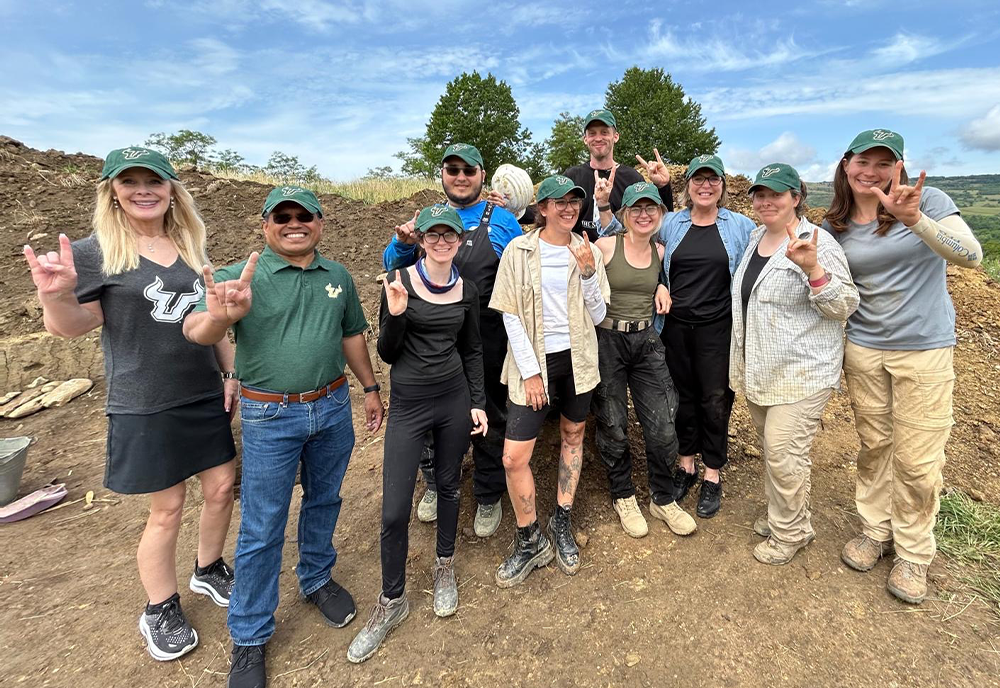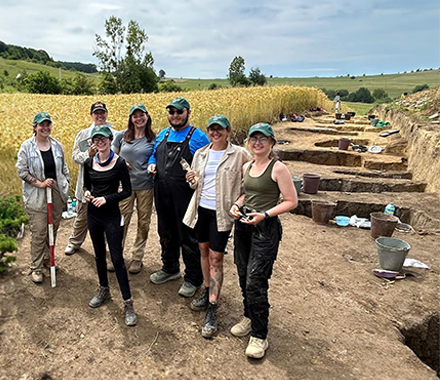 About 85 students from USF and around the country participate in the project each
summer. The excavation project was initiated by the regional museum director to fully
document the community’s complex history
About 85 students from USF and around the country participate in the project each
summer. The excavation project was initiated by the regional museum director to fully
document the community’s complex historyThe Romanian region yields its secrets under the careful work of Jonathan Bethard and students from USF and around the world.
When USF bioarcheologist Jonathan Bethard mentions his work in Transylvania and the summer field school he leads excavating a burial yard in a small village there, the conversation unsurprisingly turns to vampires.
Yes, Bethard says he typically responds, he and his students are working on unearthing more than 800 years of history in the Romanian village outside of Odorheiu Secuiesc, which was once a part of Hungary and carries a complex political and social history. No, they haven’t dug up any vampires — nor is that the reason why for the past decade Bethard has turned a Medieval former Hungarian village, at the invitation of local citizens, into a classroom for future archaeologists and forensic scientists.
But vampire legends are a great conversation starter about the summer field school which has educated hundreds of students from USF and around the country, Bethard says. It’s also an opportunity to share more insight into the fascinating disciplines that allow researchers to piece together centuries of overlapping cultures, conflict and community.
“The vampire burial is a real thing that’s been documented. Ironically there are no examples from Romania that I am aware of, but there are from Poland,” says Bethard, an associate professor in USF’s Department of Anthropology. You can connect some dots, but you can see where Bram Stoker’s artistic license come from,” he says. “It’s OK because it’s giving us at least a starting point to see what’s reality; what’s fiction; where is artistic license; and where is the role of geopolitics in how Transylvania shaped during the 20th century. There’s a lot to think about.”
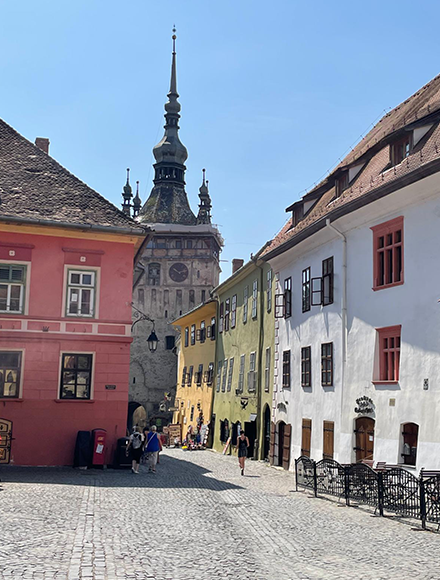
The closest field school participants might get to a vampire is a visit to Sighisoara, about 31 miles from Odorheiu Secuiesc and the UNESCO World Heritage site where Vlad the Impaler, also known as Dracula, was born
For the past decade, Bethard has been engaged in the excavation project after learning about the village’s interest in preserving its history. While working as an instructor of anatomy and neurobiology at Boston University, he noticed an advertisement from the region’s museum seeking a director for a lab-based field school in Transylvania. With an undergraduate, master’s and doctorate from the University of Tennessee — where the famed “body farm” revolutionized forensic training, scholarship and practice — Bethard has worked around the world, including as an instructor for numerous courses in forensic anthropology with the International Criminal Investigative Training Assistance Program in Colombia and Algeria and with the International Committee of the Red Cross in Tbilisi, Georgia. His 2013 dissertation was on the bioarcheology of the Inca Empire in Peru.
In the village of Odorheiu Secuiesc, the church and its surrounding property have been in use for centuries, but knowledge about how its generations lived was limited. An earthquake in 1802 destroyed the original village church, which was then razed and rebuilt with a cemetery created on top of the site. “If you dig in a Medieval church yard, you are going to find human remains,” Bethard notes.
To get there, visitors fly to Bucharest and then travel through the Carpathian Mountains. The small village where they do their work is within walking distance of Odorheiu Secuiesc, which has a population of about 30,000. The region was the site of the southwestern front during World War I, which left the borders between Romania and Hungary redrawn. But the community and its culture remain deeply influenced by Hungarian people and the long echoes of the historic conflicts in the region, which includes the spark that lit the fuse of World War I – the assassination of Archduke Franz Ferdinand.
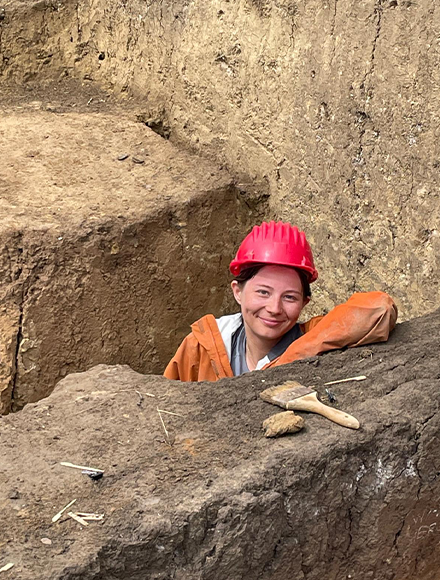
Elizabeth Rodriguez is a USF senior majoring in anthropology
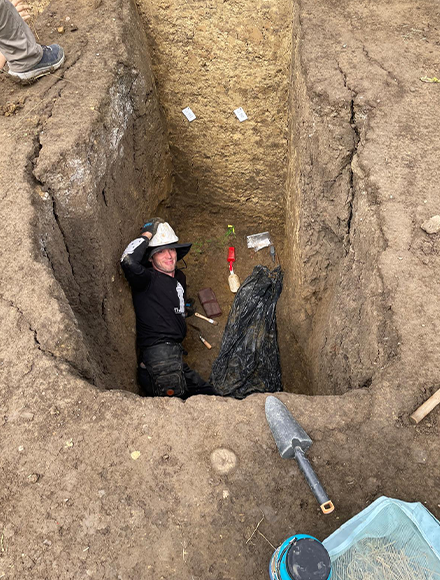
Ian Alpaugh, is a recipient of the Genshaft/Greenbaum Passport Scholarship and is a senior majoring in anthropology
More than 85 students from USF and around the country participate in the project each summer. About two-thirds of the students painstakingly excavate the burial site while a second group works on identifying the bones that are collected, extracting any information they can to develop a biological profile of the person. The grave excavations are particularly sensitive, with students toiling in the summer heat and using small brushes to gradually remove centuries of dirt from the bones while hunting for artifacts that might also be buried around the gravesite. It is not easy work, Bethard notes.
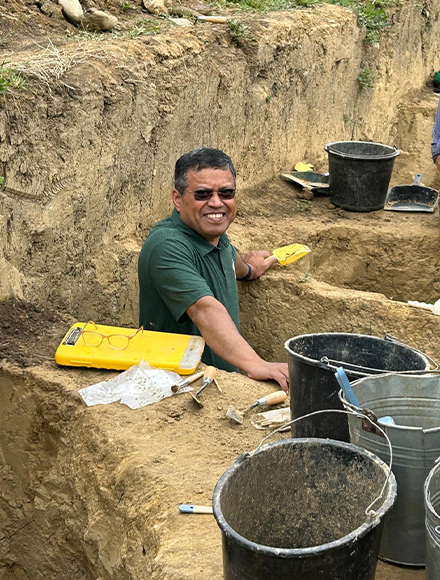 USF Provost Prasant Mohapatra gets a feel for the painstaking excavation of graves
USF Provost Prasant Mohapatra gets a feel for the painstaking excavation of gravesUnlike forensic scientists, who seek to discover an individual’s history in their examination of remains, bioarcheologists seek to tell a community’s story through their collective findings. “I feel a sense of responsibility to provide my local colleagues with the information about their ancestry,” Bethard said. “Over the last 10 years, we’ve dedicated our work to understanding the region’s complex history. It takes this level of commitment to be as thorough and exhaustive as we are. This summer USF Provost Prasant Mohapatra, USF World Vice President Kiki Caruson, and Education Abroad Director Amanda Maurer visited the research sites and spent two days learning about the various aspects of the field work. Provost Mohapatra noted: “It was fascinating to see the students working in the field and the level of energy and enthusiasm that they brought to the project. These types of programs demonstrate how fulfilling research can be in a very tangible way.”What is particularly notable about this international research experience is the number of students who chose to pursue graduate study. It is a robust training ground for future scholars. “I was so impressed by the level of respect and maturity that the students displayed with regard to handling and analyzing the remains of the community’s ancestors”, said VP Caruson. “It is a wonderful opportunity for students to engage hands-on with the field bioarcheology in an international setting.”
Each year, USF Education Abroad supports study abroad programs, research experiences, and internship opportunities that give students the opportunity to hone essential skills such adaptability, perseverance, courage, and the ability to engage with people different from themselves. Students return from a study abroad experience with greater self confidence and more insight into their goals for the future.
Planning for the 2025 summer field school is underway. To learn more about the program and apply for it, visit ArchaeoTek Archaeology. Read more about Dr. Bethard’s work around the world here.
